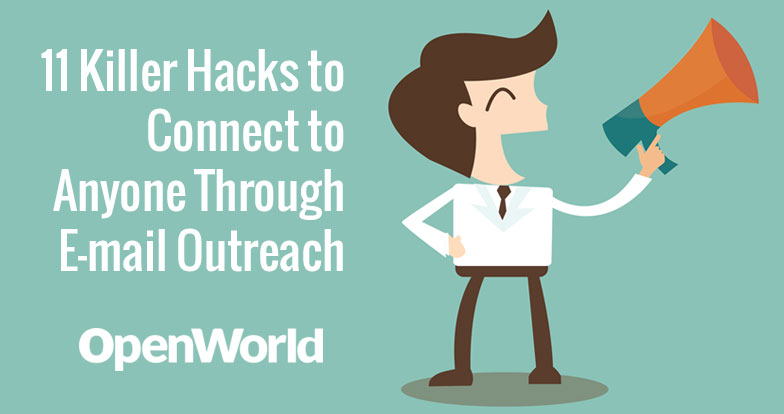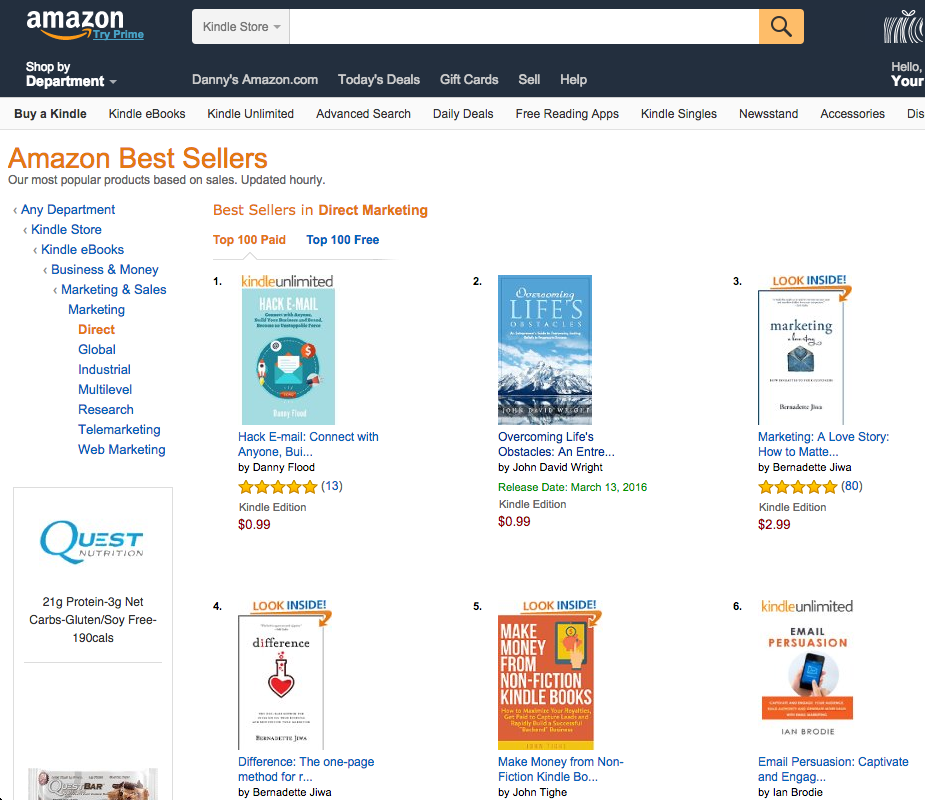
The last couple of months have been very busy! At the end of October I published by book “Hack Sleep” which became a best-seller. A month later, my first Udemy course was live. One week after that, I launched my Indiegogo campaign.
By far, the most daunting component of launching a crowdfunding campaign is being overwhelmed by all of the information and the checklist of all the things you have to do.
Should I put in the extra work to build an e-mail list just for my crowdfunding campaign? Should I try to pitch the media? Should I be a guest on certain podcasts? Guest posts? Do I need to get my magazine featured on Pinterest? Or is Instagram better?
Most important: is all of this going to waste my time while yielding disappointing results??
As a one-man team with VERY limited time, I had to be selective about how I was going to run my campaign. I couldn’t possibly be everywhere at once, and initial tests with certain strategies yielded poor results.
Guest posting yielded only one pledge – of $3. Two e-mail broadcasts to my two newsletters yielded only one pledge of $25. Being a guest on other podcasts only brought pledges from the podcasters themselves – but the audience didn’t contribute.
I knew, given all of the options to choose from and all the information to wade through, that to have any chance of making my crowdfunding successful I had to identify and focus exclusively on my strengths.
I knew from experience that this is the way to get ahead in any entrepreneurial endeavor: focus on your strengths and exploit them to the fullest. Even better, turn perceived weaknesses into strengths whenever possible (a topic for another post).
For me, my two strengths in 2015 have been precisely what I’ve written my last two books about: sleep hacking and e-mail outreach.
Polyphasic sleep means I can be as twice as productive as anyone else by sleeping less and keeping my energy levels high throughout the day. And I know from extensive marketing experience that one-on-one e-mail outreach kicks the crap out of any form of marketing or sales.
With these two “super powers” at my disposal, I had confidence going in to this campaign that I could succeed. I’ve talked quite a bit about sleep hacking lately, especially in this post, but I’ve never given away much on this blog about the fine arts of killer e-mail outreach.
So, here it is. I’m going to give away some of my best secrets, on this blog, for free. These hacks are direct from my #1 Amazon best-selling book, “Hack E-mail.”
In this post you’ll find:
- Message templates
- E-mail subject lines
- Influence and compliance tactics
- Attention-grabbing follow ups
- Successful pitch examples
- Other sneaky strategies
Many of the techniques here you can copy and paste and apply to your own business. Enjoy, and use them well! And if you like this post, you’ll love the book, as this excerpt is just about 10% of what’s inside the book. It’s just $2.99 on Amazon.
The Art of Killer E-mail Outreach
Here’s an example of a good outreach e-mail that I received recently. It’s not perfect – there is little in the way of personalization in particular – but it’s certainly not half bad. Let’s talk about this e-mail does right (and what could be better).
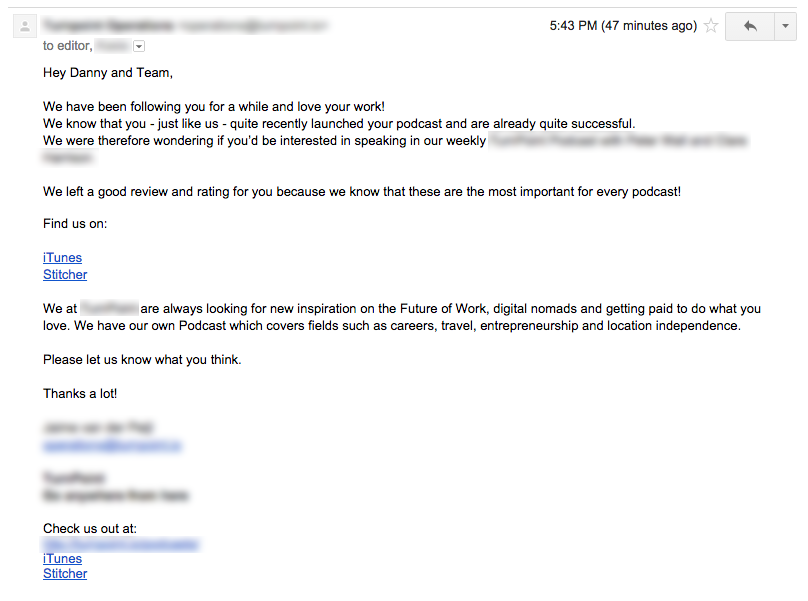
First, the e-mail starts out the right way. He e-mails my “editor” address, but correctly surmises my first name (which, as we saw in the examples above, doesn’t always happen). Then he uses the first line to mention that he’s been following me and praises my work. So far, so good.
Then it gets even better. Can you see what this e-mail does really well?
It’s there – hidden in plain sight.
What this person did exceptionally well is he engaged the so-called “law of reciprocity.” The “law of reciprocity” is one of the six so-called “weapons of influence” detailed in the book “Influence: How and Why People Agree to Things” by Dr. Robert Cialdini.
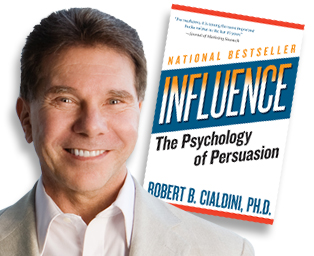
In his book, Cialdini describes an experiment that was performed at Cornell University in 1971 where participants of two control groups were offered to purchase a raffle ticket (the value of a ticket was twenty five cents). Group A was approached and asked directly to buy a ticket. The participants in Group B, on the other hand, were offered a Coca-Cola first.
The result? The test subjects who had received a Coke before the request was made purchased twice as many raffle tickets as the other group!
In the 1960’s, the Hare Krishna religious group was in a bind financially. To solve this, they put the law of reciprocity to work. Members of the group would go to public places such as airports and approach strangers to request a donation. They quickly found out that by offering a flower to a stranger first, the recipient was much more compelled to comply with their request.
In many cases, the flower was simply disposed of after the incident. It did not matter. The flower achieved its purpose, and the religious group raised millions in funds this way. As humans, we feel compelled to return favors and help those who have helped us, even when we do so begrudgingly. Interestingly enough, the group members would visit the garbage bin, re-collect the flowers after they had been thrown out, and repeat the process.
Going back to the e-mail above, activating the obligatory nature of the law of reciprocity – where favors are returned with favors – is what this message does very well. As a fellow podcast host, he knows that reviews are important to my podcast. He offered me the proverbial “flower” to increase the likeliness that I would agree to his request.
Two other things which increased the likelihood that I would respond favorably: one, he speaks the same language as me. People in every single niche, industry, sub-group, or hobby tend to have their own “secret language” that’s exclusive to them. Golfers use all kinds of slang, and so do surfers. Podcasters have their own language, and so do backpacking entrepreneurs like myself.
In his e-mail, he mentions a variety of buzzwords and topics which are near and dear to my heart: “digital nomads, getting paid to do what you love, and location independence.” By dropping this language, he’s showing that he’s an “insider” and someone I should pay attention to.
Second (and this is something I’ll touch on a bit more later), he mentions in the very beginning of the e-mail that he’s following my work. If he’s a subscriber to my e-mail list, or a listener to my podcast, then he falls in the group of people who allow me to do what I do.
Without my audience, customers, and clients, I wouldn’t be able to support myself. By being a follower of my work, it increases the chances that I will respond to him favorably.
On the other hand, there is very little “What’s In It For Me” factor. While I’m certainly willing to be a guest on almost anyone’s podcast, even new ones with a small audience, this message features a glaring lack of a suggested benefit to me, the recipient. Further, each line begins with “We” which implies that the senders are prioritizing their own needs over my own.
How to Write an Awesome Outreach E-mail
To score a strike in bowling, every single pin needs to be knocked down in order for it to count. Similarly, in the game of baseball, a runner needs to touch every single base in order to score a run. Even if he hits the baseball out of the park, the rules state that he must make the rounds and touch first base, second base, third, and finally home plate.
What am I getting at with this?
To perform successful e-mail outreach, there are several aspects that you need to address, or “bases” to touch in order to score a home run.
To make your e-mails most effective, there are several components that your e-mail should clearly communicate.
Your takeaway from this chapter should not simply be a breakdown of what the perfect e-mail outreach looks like from a compositional standpoint, but an understanding of the principles and nuances that make for excellent e-mail communication.
By combining these principles and nuances into one message, you can create communication (and e-mails) that become more and more irresistible.
The Three C’s of Your Initial E-mail

1. Be clear
Speak in the active tense (ie: “The dog ran into the house,” not “the house was ran into by the dog”). Make sure that every word, every sentence reads clearly and there is nothing that could be misunderstood. Never put the onus on the recipient to try to translate what you’re saying or what you’re asking of them.
2. Be concise
Don’t let your sentences – or paragraphs – run on for too long. Don’t use more words than is necessary. Show that you respect the person’s time, and that you also value your own time.
3. Be courteous
Provided that the person you’re reaching out to is someone of repute, you should communicate with utmost respect.
My friend Sean D’Souza of “The Three Month Vacation” podcast told me his definition of a client is someone: “under your protection, care, and guidance.” Likewise, Walt Disney insisted that his customers be thought of and referred to as “guests,” treated just as an honored guest in one’s home.
You should adopt this very mindset from the outset when you first e-mail someone. Treat the recipient of your e-mail the same way as you would an honored guest in your home. Let your words ring with politeness, respect, and courtesy.
Create Psychological Anchors: Compliment their work
Complimenting someone on their work is VERY effective. It is very powerful to make people feel good when they open your e-mail, because it flips a psychological switch in the recipient’s brain. With your compliment, you create a positive neuro-linguistic “anchor” by associating yourself to feelings of pleasure.
When you offer your compliment, try your best to be very specific. You can mention a passage from their blog, or an article that they were featured in, and explain the effect it had on you.
A simple Google search and a bit of research can perform wonders. Check the recipient’s blog, website, and social media profiles. See what they are posting and find something that you can connect over. On the flipside, few things will earn you more scorn from the outset than a lack of familiarity with the person you’re attempting to connect with in the first place.
There are advanced search strings you can enter in to Google to facilitate proper due diligence before e-mailing someone. For example, recently I wanted to e-mail a reporter from National Geographic Travel about a feature I had written in Cambodia. Instead of offering some boring, abstract compliment like “I love the articles on National Geographic Travel!” I entered this specific search string into Google first:
site:natgeotraveller.co.uk cambodia
Here’s what this does: when you enter the prefix “site:” before a search, Google will go to work to return results ONLY from the website that follows. Then you can simply add in any keywords you like after, such as “cambodia.” This is a great way to find specific articles related to topics such as yours, with pinpoint accuracy.
This little technique can give us the leg up when it comes to finding something specific with which to reach out to our recipient and build rapport over. It also shows that we’ve done our homework.
The Power of Positive Speech
Mark Twain said that the difference between the right word and the almost right word is the difference between lightning and a lightning bug.
This is especially true when making your first impression through e-mail outreach.
Whenever possible, I use positive subject lines (I have a full list of these with examples in my book “Buy Your Own Island”).
It doesn’t have to be complicated.
“Thank you!” is a great one. “Loved your article” is another. On the flipside, avoid bad, boring subject lines.
If your initial e-mail is your first impression then a great subject line is like a Berloni suit with tie. A bad or boring subject line gives off the appearance of shabbiness, unoriginality, and carelessness.
Again, it’s about creating a positive psychological “anchor” so that someone perks up when they see your e-mail in the sea of messages. You want someone to welcome correspondence from you, and the easiest way to do that is by using a positive subject line.
Subscribe to their email list

One of the easiest ways to get your foot in the door is to simply subscribe to the recipient’s mailing list (or become a user of their product).
Here’s why: no marketer, blogger, or entrepreneur wants to upset their e-mail subscribers – after all, subscribers comprise their primary leads and/or active clientele.
Simply becoming a subscriber of their mailing list, reader of their blog, listener of their podcast, or user of their product (whatever the case may be), increases their obligation to respond back to you in a favorable manner.
Demonstrate Value: Occupy the Moral High Ground
“You know, a few days ago, when we were sitting down with Barack Obama, I turned to these guys and said, ok, you know, we’re making a lot of money. And yes, we’re disrupting digital media. But most importantly we’re making the world a better place. Through constructing elegant hierarchies for maximum code reuse and extensibility.”
– Silicon Valley

You should be able to demonstrate your own value and self-worth without going on for too long or rambling. One or two sentences introducing who you are and your current or past projects is enough.
Where does value come from?
Value comes from your mission – your objective. If you have a powerful “WHY” that in and of itself is a sign of value.
Many people are like ships drifting at sea with no particular port as their destination. We never want to communicate that we are like that – aimless, without value of our own time or any worthy goal driving us.
People are drawn to others who are on an important mission, who are working on important projects.
If you don’t have some “marvelous mission” that’s driving your professional endeavors, then find one. It’s not that hard to do: just think of the problem you solve or the benefits you provide for the people you influence. Make your mission about helping others, rather than yourself. “I want to be a millionaire” is not as compelling as “I want to create one million millionaires.”
Define your ultimate mission, and that becomes your value that you can communicate to others.
Demonstrate vulnerability

At the same time, demonstrating a chink in the armor – just a touch of vulnerability – can be very compelling. You don’t want to evoke outright pity from the other person, but you don’t want to be too self-assured either.
It is enough to simply show that you are human. In the book, “One Simple Idea,” author Stephen Key recommends the six words: “I could use a little help,” when making cold calls to gatekeepers, adding that they can be powerfully persuasive.
A simple phrase like “I could use a little help,” implies that you are not perfect, that you’re striving to succeed in some important endeavor, and that a small favor can help make success possible.
Also, you don’t want to *inject* too much of your personality in to correspondence when first communicating with someone. Yes, you are an unique snowflake, but you don’t want to project too much of that from the outset. It becomes a liability with little to no potential benefit.
It is far better to gauge the nature of the person whom you are communicating with first to see how they respond to you. Then watch how the relationship progresses to assess whether the more quirky aspects of your personality will be well-received. Being too quirky, or making jokes too early on can turn people off.
For this reason, it is far more effective to keep the tone of your initial e-mails polite, complimentary, and to the point.
Entice and Enchant Them

I’m not a fan of offering “quid pro quo” offers to people or offering financial incentives. Few people want to be bribed, even less so by a stranger, and to come across as trying to bribe someone by appealing to their greed comes across as sleazy.
However, if you make an offer to help to promote someone else’s work within your network or audience, it can go over very well.
Example:
“John, I’m a big fan of your book, and I especially liked the part about [specific details]. I’d love to help you get this message out in front of more people. I’m the host of a podcast with 20,000 monthly listeners, and would love to record an interview with you. My audience would love this. We can also add a special offer to encourage people to download your e-book.”
At the same time you entice them, you can also enchant them with a compelling story. Think about your mission (see above: Demonstrate Value) and align it to a storyline.
Here are five examples of compelling storylines that you can adopt:
1. Great aspirations. The hero wants to make the world a better place and know there must be a better way. Working nights and weekends, he creates something that people love more than their wildest dreams.
2. David vs Goliath. Goliath has a head start, incredible resources, and a cast of thousands. But David takes him on and defeats him, showing that the underdog can succeed.
3. Profiles in courage. Injustice, pain, and suffering are making our heroes’ lives miserable. Despite these woes, they persevere and accomplish great things.
4. Personal stories. “Epic” is not always necessary. “Illustrative” is enough – talk about your personal experience doing something, or using a product.
5. Connecting the dots. The hero reaches a new level in her life and wants to share with others how she got there to help others who were in her situation.
If you can position what you’re doing (your mission) with one of the storylines above, it can make your message much more compelling. A compelling story works especially well when contacting journalists, podcasters, and so on.
Moreover, a storyline like this can easily be adopted for your overall personal brand and message. You can adopts these storylines for uses, such as putting them on to your website, landing page, or crowdfunding page.
Name Dropping – a Powerful Hack to Gain Attention
“Tyler said it’s cool,” were four words that came out of my mouth that evoked immediate and complete compliance.
What am I talking about? And who is Tyler?
Anyone who has ever tried to get access in to a hot nightclub should very well know the power of name dropping. Nightclubs are not obligated to provide access to anyone, to increase your chances of “getting in the door,” it always helps if you know someone.
Here’s the kicker though: as long as you know the name of an owner or manager of the club, you can in many cases “name drop” your way in the door, even if you don’t actually know the person very well (or at all).
The same principle applies to any situation where you approach someone cold, whether via e-mail, a phone call, or in-person.
You can bypass a stranger’s innate “I’ve never heard of this person” skepticism simply by associating with someone or something that they have heard of.
Let me tell you a story of a recent personal example.
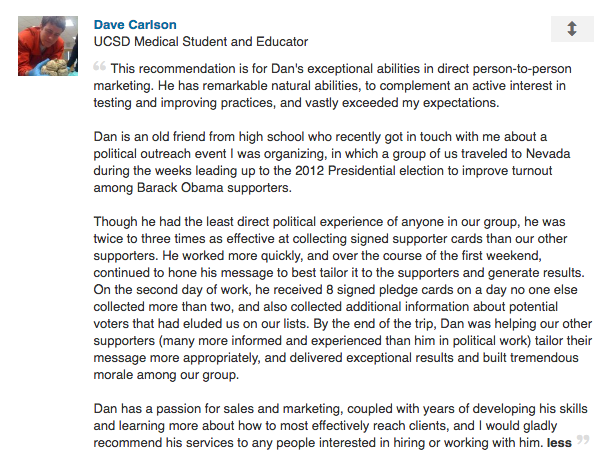
During the 2012 Obama presidential campaign, I was the most successful door-to-door canvasser in Nevada, collecting the most signatures in the Las Vegas district.
Our organizers gave us a list of leads and scripts to read as we went from house to house to deliver our pitch and collect signatures. In two days of knocking on doors, I was able to collect five times more signatures than the average canvasser. By the second day, I was training the other volunteers in ways to improve their pitch.
My secret was very simple. I read over the script they handed us, and realized that were a few ways in which it could be improved upon. The key, however, was in the introduction. In the script, the introduction said something like:
“My name is Danny, and I’m here on behalf of Organizing for America.”
I had never heard of Organizing for America, and I’m pretty sure that our prospects never had either. So instead, I made an easy and obvious change:
“My name is Danny, and I’m here on behalf of President Obama.”
If someone knocked on your door, and told you that they had come on behalf of the president of the United States, wouldn’t that arouse your curiosity?
You bet it would!
Here’s the thing… all too often our messages are weak, and don’t deliver an impact. You can easily make an impact in your e-mail outreach by putting the principle of association to work.
Brian Grazer, renowned Hollywood producer of “A Beautiful Mind, “Apollo 13,” “The Da Vinci Code,” “Arrested Development,” and countless other movies and television series, used the principle of association to its utmost to build key relationships and work his way to the top of his profession.
When Brian was a very young man he got a three-month internship at Warner Brothers, where he worked as a clerk in the business affairs department, pushing a cart around.
There, he used his position to get all kinds of inside access – legal contracts, business contracts, movie proposals, and so on. He would call someone every day and say “I’m Brian Grazer. I work at Warner Brothers business affairs. I want to meet you.”
He turned his three-month internship in to a year and was eventually fired, but not before selling two ideas to NBC for five thousand dollars each.
As Malcolm Gladwell, in the book “David and Goliath,” elaborates:
“It never occurred to the people Brian Grazer called that when he said he was Brian Grazer from Warner Brothers, what he meant was that he was Brian Grazer who pushed the mail cart around at Warner Brothers.”
There are always causes, people, places, anything – that you can associate with that immediately familiarizes yourself with the recipient. By the simple act of creating this association, you are no longer a stranger, but someone who shares common interests, a kindred spirit. You can also mention a mutual friend, or connection. Or you link yourself to an authority, as Brian Grazer did at Warner Brothers and the way I did during the Las Vegas canvassing campaign.
Tim Ferriss, multiple New York Times best-selling author, and “the greatest self-promoter in the world” according to Wired magazine, has used the principle of association time and time again throughout his entrepreneurial career to catapult himself to the next level.
Before he won reknown from his books, Tim leveraged the authority and reputation of the non-profit organization in which he was a member – the Silicon Valley Association of Startup Entrepreneurs – to establish relationships with ubersuccessful entrepreneurs and mentors.
Then, years later, he leveraged the success of his first book (“The 4-Hour Workweek”) to gain access to all types of people for his second and third books, “The 4-Hour Body” and “The 4-Hour Chef.” He interviewed everyone from Guinness World Record holders to world-famous sous chefs to pickup artists to trainers of Olympic athletes.
Because he had already written a #1New York Times best-selling book, it was considerably easier to get all of these different types of people to agree to an interview than if he had attempted to reach out to them all prior to writing the “The 4-Hour Workweek.”
Never one to miss an opportunity, Tim eventually leveraged his reputation as an author and his books to take on other industries, such as angel investing. No question about it, associating with well-known and successful brands and authority figures is one of the most powerful ways to influence others and create the types of relationships you seek.
Oh, and remember those bouncers? I would never ask for something of someone without giving something back. After they granted me access to the nightclub I would express my gratitude, and always offer to return their favor with a favor of my own: “Can I bring you a drink or something? Maybe even a water?”
If you return a gesture with a gesture it immediately resets the karmic balance. If someone grants your request, you should express your gratitude and promptly make an offer to reward their action.
As cryptic as it may sound, this also “trains” the other person neurologically to want to do things for you. It all goes back to creating an “anchor:” the action is returned with a reward, encouraging a loop of more actions and more rewards.
It sounds crazy, but it’s true. I’ve built some of my strongest business relationships this way. I’ll cold e-mailed someone else in my industry and by asking and giving back, we have been able to support one another in our respective business endeavors for years.
These business contacts are so invaluable, because of a simple bond that forms and an understanding that we will readily help one another if anything is ever needed.
If They Don’t Respond – Templates to Use
There are a thousand reasons why someone may not respond. Influential people tend to be very busy, receive a lot of e-mail, and could miss your initial e-mail for any number of reasons (or they could simply forget to reply).
The rule of thumb is that the lack of a response usually has to do with external circumstances which are not immediately clear. It always has more to do with them than it does you, so never take it personally.
The question is: should we follow up or shrug it off and move on? And if we do follow-up, what’s the best way to go about it?
Wait one week and if the person still hasn’t responded, hope is not lost. In fact, it is a great opportunity to send a follow-up, and make it clear that you are awaiting some form of reply.
If one week passes, and you still have not received any reply, send a follow-up message with this subject line:
“Did you get this e-mail?”
This is perhaps my favorite subject line. It is VERY powerful.
This subject line immediately grabs their attention, and in most cases virtually compels the person to respond. You also demonstrate that you are expecting some form of reply, even if it’s just to turn you down. This is important because many people slink away if they don’t hear from someone and give up too easily.
Another powerful tactic you can use if you don’t hear back from someone is simply to ask the person why. This encourages them to respond. There have been several instances when someone has asked something of me, and after I turn them down I wish they would ask me why. But they didn’t. They simply gave up, said thanks, and went on their way with their request denied.
The principle of asking “why?” when your message is not replied to or when your request is denied is modeled after the “lost-sale close” used in sales interactions.
The lost sale close occurs after a sales interaction when a salesperson delivers his value proposition, answers the prospect’s objections, and asks for the order, but the prospect still says “No,” or “I’ll get back to you.”
Just as the salesperson is about to leave, he turns and asks:
“Mr Prospect, may I ask you a question? I’ve done my best to present my product in the best way I know how, but feel as though I’ve done something wrong. I’d appreciate it if you could you tell me something: what the real reason you didn’t buy today?”
If someone doesn’t respond, or says no, you can use some variant of this in your follow e-mails (just replace the interview reference to whatever you like):
“Hey Mr Smith, just a friendly follow-up 🙂
If an interview is not in the cards at the moment, then that’s fine, no worries.
But if possible, could you tell me the real reason why you wouldn’t want me as a guest on your show? I’d like to get your feedback so I know how I can improve.”
In many cases, this tactic can initiate (or reinitiate) and lead to the desirable outcome that you seek.
Oftentimes, a conversation will stale out once the other party has asked you for a proposal or asked you to present your price. You answer, and then they disappear. This happened to me recently when a company inquired about my advertising rates on my blog.
If this scenario happens to you and you don’t hear back from the person after one week, send them a follow e-mail like this:
“Hi Name,
As I haven’t heard back from you on this matter, I assume your priorities have changed.
Regards”
That’s it. There’s no secret formula, but there are ways to automate the follow-up process (see below, and next chapter for specific e-mail tools).
In a successful example of persistent follow-up in action, I reached out last year to an author to invite him to be a guest on my podcast.
First, it took several emails before he agreed, and then he suggested that it be put off until he was less busy / closer to finishing his book. The point is… this particular podcast interview was months in the making, after a good deal of back-and-forth e-mail exchanges and delays.
Nevertheless, I persistently and politely followed up at regular intervals, and continued to both offer value and demonstrate value.
Even when we first began to record the interview, I could still sense a lingering sense of apprehension and/or trepidation, until I was able to make him feel relaxed and open up.
The result?
He wrote me this follow-up e-mail to me after the interview:
“Hi Danny,
It was such a pleasure speaking with you as well! Honestly, I had the best interview with you out of all the interviews I have done for the past few months. You did tons of homework and asked very insightful questions. It helped a lot to put me at ease.
Hope our paths will cross again in the future.”
When this guest began thinking about PR outlets for his book, he was likely thinking of established names like “Entrepreneur Magazine,” “Forbes,” and “INC.” Chances are he had never heard of “OpenWorld” prior to my initial e-mail.
However, by observing the communication steps outlined in this post: by making my mission clear and by demonstrating knowledge, credibility, and value in every single interaction, I was able to win him over.
If you’re an entrepreneur, even with a brand that no one has ever heard of, you can win over hearts and minds in exactly the same way. It all comes down to the way you communicate and present yourself.


